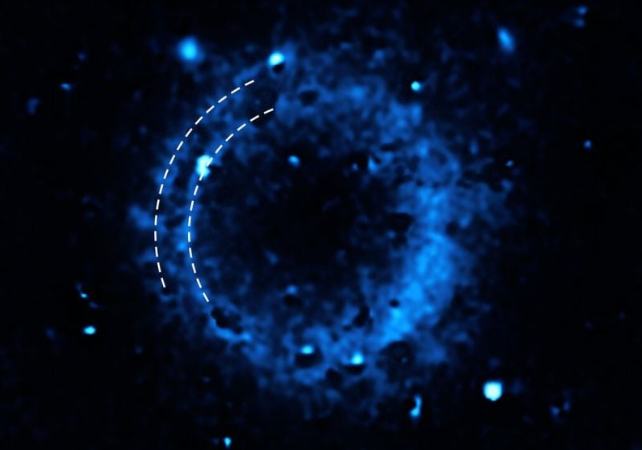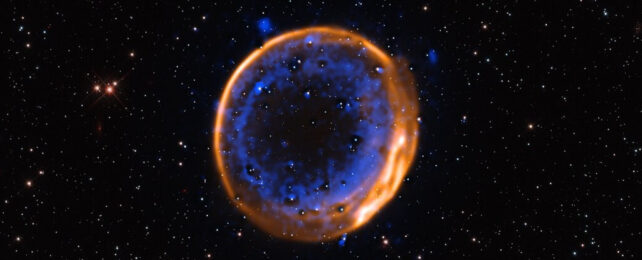All supernovae are massively energetic stellar explosions. The classic supernovae are massive stars that explode near the end of their lives, leaving behind either a neutron star or a black hole, and a remnant made of expanding gas and dust.
But supernovae are not all the same. Some occur in binary systems, and they're called Type Ia supernovae. As it turns out, some of these Type Ia SNe can detonate twice.
Astronomers working with the European Southern Observatory's (ESO) Very Large Telescope (VLT) have detected patterns showing that an ancient supernova exploded twice as a Type Ia. The supernova remnant is called SNR 0509-67.5 and it's about 160,000 light-years away in the Large Magellanic Cloud (LMC).
The discovery is explained in new research in Nature Astronomy titled "Calcium in a supernova remnant as a fingerprint of a sub-Chandrasekhar-mass explosion." The lead author is Priyam Das, a PhD student at the University of New South Wales Canberra, in Australia.
Related: Rare Star Doomed to Explode Finally Confirms Astronomical Prediction
One of the stars in a Type Ia supernova is always a white dwarf. White dwarfs are the evolutionary end-states of stars that aren't massive enough to become a neutron star or a black hole. Our own Sun will end its life as a white dwarf after it has ceased fusion.
The white dwarf's companion star can range from another white dwarf to a massive star. White dwarfs are extremely dense and their gravity draws gas from the companion onto the white dwarf's surface. If enough mass accretes, the white dwarf crosses a threshold and can reignite and trigger a supernova explosion.
However, astronomers are uncertain about some of the details surrounding these supernovae. Type Ia SNe play an important role in the galaxy by creating iron, and astronomers want to know more about them.
"Type Ia supernovae play a fundamental role as cosmological probes of dark energy and produce more than half of the iron in our Galaxy," the researchers write in their article.
"Despite their central importance, a comprehensive understanding of their progenitor systems and triggering mechanism is still a long-standing fundamental problem."
"The explosions of white dwarfs play a crucial role in astronomy," said lead author Das in a press release. "Yet, despite their importance, the long-standing puzzle of the exact mechanism triggering their explosion remains unsolved."
Astrophysicists have struggled to explain how Type Ia white dwarfs work. One popular explanation is the Chandrasekhar-mass explosion model. The Chandrasekhar limit is a mass limit for white dwarfs of about 1.4 solar masses.
Below this limit, the white dwarfs electron degeneracy pressure supports the star against gravitational collapse. When the white dwarf breaches this mass limit by drawing matter from its companion, carbon fusion ignites across the star and it explodes as a Type Ia SN.
As researchers have observed more and more WDs, this model has been called into question. It can't account for the number of Type Ia SNe, and many of them appear to be exploding below the Chandrasekhar mass limit. These are sub-Chandrasekhar mass Type Ia SNe.
A new model emerged to explain these sub-Chandrasekhar mass SNe called the double-detonation model. In this model, the WD accretes helium onto its surface until it explodes. The explosion sends shockwaves both inward and outward.
White dwarfs have carbon-oxygen cores, and the inward-travelling shock compress that core. If the shock is powerful enough, it triggers a second detonation in the core, hence the term "double detonation."
Even though astrophysicists have predicted these double-detonation SNe, there was no clear visual evidence. As researchers worked on the problem, they predicted what chemical 'fingerprint' these SNe would leave behind. They found that two separate shells of calcium would be the result of double-detonation Type Ia SNe.
The research team used the VLT and its Multi-Unit Spectroscopic Explorer (MUSE) instrument to examine SNR 0509-67.5 and found two distinct calcium shells. "We uncover a double-shell morphology of highly ionized calcium [Ca XV] and a single shell of sulphur [S XII], observed in the reverse shocked ejecta," the authors write.

The results show "a clear indication that white dwarfs can explode well before they reach the famous Chandrasekhar mass limit, and that the 'double-detonation' mechanism does indeed occur in nature," according to research co-author Ivo Seitenzahl.
Seitenzahl led the observations and was at Germany's Heidelberg Institute for Theoretical Studies when the study was conducted.
These double-detonation Type Ia SNe explain some of the things astrophysicists have observed. They can explain the diverse brightness and spectral profiles of Type Ia SNe, and the helium burning can produce intermediate-mass elements seen in their spectral signatures. It can also explain the Type Ia SNe astronomers see with different WD masses and companion types.

The authors explain that a quadruple-detonation SN is also possible when a binary pair of white dwarfs merge.
"Recent multidimensional double-detonation simulations show that, in the WD merger scenario, in addition to the primary WD undergoing a double detonation, the companion WD can also undergo a double detonation (resulting in a 'quadruple detonation') upon being impacted by ejecta from the exploding primary WD," they write in their conclusion.
"Such a double double detonation could possibly also lead to the observed double-shell structure of calcium."

Type Ia SNe play important roles and a deeper understanding of these cosmic explosions will help scientists understand a couple things.
The SNe serve as standard candles in the cosmic distance ladder and understanding them will help cosmologists understand dark energy, the mysterious force that drives the expansion of the Universe.
They also produce a lot of the iron in the Universe. Earth's mass is about 32% iron, and it's unlikely that rocky planets can form without iron. Iron also transports oxygen in our blood, a critical part of our nature. Understanding where it comes from helps us understand Nature's overall architecture.

They also produce a lot of the iron in the Universe. Earth's mass is about 32% iron, and it's unlikely that rocky planets can form without iron. Iron also transports oxygen in our blood, a critical part of our nature.
Understanding where it comes from helps us understand nature's overall architecture.
This article was originally published by Universe Today. Read the original article.
